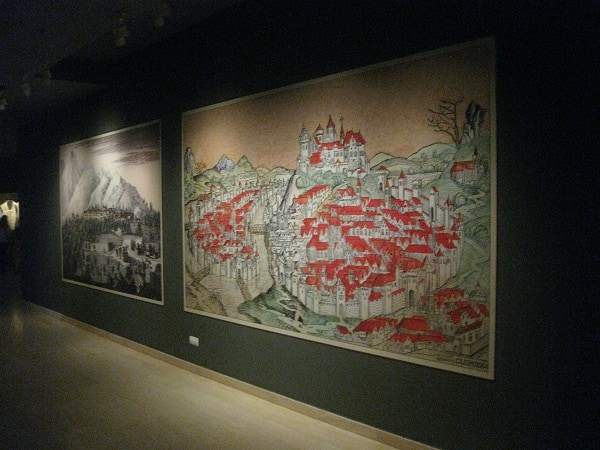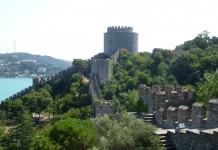Going to the Sakıp Sabancı Museum (SSM) located on the coast of the Bosporus in Emirgan is always a treat. The SSM is one of the best museums not only in Istanbul, but also in Turkey, and the exhibitions that it brings are always a collaborative endeavor between scholars, artists and institutions from a variety of countries. “Distant Neighbour Close Memories: 600 Years of Turkish-Polish Relations,” the 10th exhibition I have seen at the SSM, follows the high standards the museum has previously maintained. The main focus of the exhibit is obvious from the title, and the exhibit highlights numerous realia that further demonstrate this relationship.
As you enter the exhibit, which begins on one of the lower levels of the museum, you first see a timeline — one wall in Turkish and the other in English — showing the origins of Turks and Poles in parallel. An interesting fact I learned: the Polans or Polanie tribe meant “plains dwellers,” most likely reflecting where they originated from.
The timeline shows how the Ottomans and Poles first made contact during the medieval period, with commercial relations centered on textiles and silks being sent from the Ottoman Empire to the Polish Kingdom based in Krakow to be exhibited at the homes of the aristocracy and nobility.

As the Ottoman Empire and the Kingdom of Poland expanded, war, particularly over the region of Crimea, became one of the defining characteristics of their relationship. This is reflected in the collected artifacts displayed on the second level of the exhibition. On this floor, a variety of military weaponry is featured, including swords, bows, arrows and maces used for hand-to-hand combat. One of the most impressive features on this floor is the recreation of a tent dwelling where military commanders would stay during their long campaigns fighting in central Europe.
The exhibition moves chronologically toward the Battle of Vienna in 1683. The curators suggest that this is the beginning of the end of Ottoman domination of Central and Eastern Europe. This battle, which was won by the Holy Roman Empire, which the Polish Kingdom supported, defeated the Ottoman forces due to the patience of Polish King Jan III Sobieski. A portrait of Sobieski, along with other Polish nobility, is featured on the lower two levels of the exhibition.
In the aftermath of a long period of warfare, The Kingdom of Poland lost its independence due to the machinations of the Russian Empire under Empress Catherine, the Austrian-Hungarian Empire and the Prussian Kingdom. You can get a sense of how, throughout its history, Poland has been besieged by two main powers: Germany to its West and Russia to its East. As a result, Poland did not become an independent country until 1918, after the conclusion of WWI.

On the last level of the exhibition, the Polish contribution to the Ottoman Empire is made manifest through descriptions of the revolutions of 1848 and the Crimean War. Around 1,000 Polish volunteers crossed into the Ottoman Empire as a result of the failed attempt at independence in 1848-49. One of these was Konstanty Borzęcki, the great-grandfather of the famous twentieth-century poet Nazim Hikmet. During the twentieth century, many Poles died fighting as result of Nazi and Soviet invasions and suffered under Communism for over 40 years.
As you exit the exhibition, on the SSM’s first level there is a short, eight-minute animated documentary produced by the Polish government on the last 1,000 years of Polish history. I learned a great deal about Polish history and culture from this brief video, one fact of which was that the first European constitution was written by the Poles in 1791.
“Distant Neighbour Close Memories: 600 Years of Turkish-Polish Relations,” has a heavy focus on the commercial and military relations between Turks and Poles in that period. There are numerous samples of textiles and ceramics, as well as maps of Polish cities and portraits of both Polish and Ottoman rulers featured in the exhibition. The curators should be complemented for featuring artifacts from numerous archives, libraries and museums in both Poland and Turkey. For those that want to learn more about both Turkish and Polish history through artifacts of the period, I recommend making the trip up to the lovely Sakıp Sabancı Museum.
“Distant Neighbour Close Memories: 600 Years of Turkish-Polish Relations”
March 7 – June 15, 2014
Sakıp Sabancı Müzesi
Sakıp Sabancı Cad. No. 42
Emirgan, Istanbul 34467
Phone: 02122772200
Website
Tuesday, Thursday-Sunday: 10:00-18:00
Wednesday: 10:00-20:00
Closed Mondays.
Last tickets are sold 30 minutes before closing.
Museum Admission Fees
Adults: 15 TL
Groups: 12 TL
Concessions: 8 TL (students, teachers)
Wednesdays: Free










